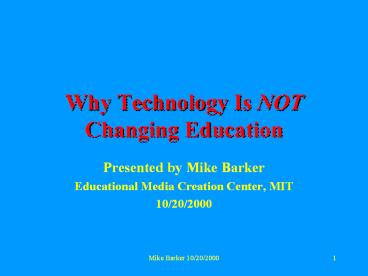Why Technology Is NOT Changing Education - PowerPoint PPT Presentation
Title:
Why Technology Is NOT Changing Education
Description:
What do we mean by education? What do we mean by technology? Let's take a ... Public Broadcasting System (PBS) MITWorld. Mike Barker 10/20/2000. 33. References ... – PowerPoint PPT presentation
Number of Views:62
Avg rating:3.0/5.0
Title: Why Technology Is NOT Changing Education
1
Why Technology Is NOT Changing Education
- Presented by Mike Barker
- Educational Media Creation Center, MIT
- 10/20/2000
2
Todays Agenda
- What do we mean by education?
- What do we mean by technology?
- Lets take a look at some!
3
What Do You Mean by Education?
4
A Definition of Education
- Systematic training and instruction designed to
impart knowledge and develop skill. (OAD)
5
What Do I Mean By Education?
- The best education starts with a great teacher
at one end of a log and a student who wants to
learn at the other end.
6
Rethinking University Teachinga framework for
the effective use of educational technologyby
Diana Laurillard
7
Teaching Persuades
- teaching is essentially a rhetorical activity,
seeking to persuade students to change the way
they experience the world. It has to create the
environment that will enable students to learn
the descriptions of the world devised by others.
8
Teaching is Mediated Learning
- teaching is mediated learning, allowing
students to acquire knowledge of someone elses
way of experiencing the world.
9
Generating a teaching strategy
- there must be a continuing dialogue between
teacher and student - The dialogue must reveal both participants
conceptions - The teacher must analyze the relationship between
the students and the target conception to
determine the focus for the continuation of the
dialogue - The dialogue must be conducted so that it
addresses all aspects of the learning process
10
Rethinking University Teaching
- Education is a dialogue!
11
What People Need to Learn
- Learner-Centered Environments
- Knowledge-Centered Environments
- Assessment to Support Learning
- Community-Centered Environments
12
Learner-Centered Environments
- Effective instruction begins with what learners
bring to the setting this includes cultural
practices and beliefs, as well as knowledge of
academic content. - Learner-centered environments help students make
connections between their previous knowledge and
their current academic tasks.
13
Learner-Centered Environments
- What you already know shapes what you can and
will learn.
14
Knowledge-Centered Environments
- The ability to think and solve problems requires
knowledge that is accessible and applied
appropriately. - Concepts must be presented in ways that link
learning to current understanding, so that
students learn connected knowledge.
15
Knowledge-Centered Environments
- We need to build knowledge and understanding, not
just a catalog of disconnected facts.
16
Assessment to Support Learning
- Feedback is fundamental to learning, but feedback
opportunities are often scarce in classrooms.
Summative assessments occur at the end of
projects.
17
Assessment to Support Learning
- What are needed are formative assessments, which
provide students with opportunities to revise and
improve the quality of their thinking and
understanding.
18
Assessment to Support Learning
- Assessments must reflect the learning goals that
define various environments.
19
Assessment to Support Learning
- I.e., we need to test our students in ways that
focus on whether they are developing
understanding and applying knowledge, and we need
to test in ways that encourage them to improve
afterwards.
20
Community-Centered Environments
- Students, teachers, and everyone else in the
community needs to value learning and hold high
standards. These values and standards increase
peoples opportunities and motivation to
interact, receive feedback, and learn. - Activities in homes, community centers, and
after- school clubs can have important effects on
students academic achievement.
21
Community-Centered Environments
- I.e., when the people around you value learning,
you will too.
22
Four Areas for Learning
23
Four Areas for Learning
- Learner-Centered what you already know shapes
what you can and will learn - Knowledge-Centered build knowledge and
understanding, not just a catalog of disconnected
facts - Assessment test for understanding and
knowledge, and encourage improvement - Community-Centered when the people around you
value learning, you will too.
24
What Do You Mean By Technology?
25
What Do I Mean By Technology?
- Web-based presentation and interaction
- Videostreaming
- Instructional Tutors
- Courseware
- Etc.
26
What Do New Technologies Offer?
- Because many new technologies are interactive, it
is now easier to create environments in which
students can learn by - doing,
- receive feedback,
- continually refine their understanding and
- build new knowledge.
27
What Do New Technologies Offer?
- Technologies can help people visualize
difficult-to-understand concepts.
28
What Do New Technologies Offer?
- New technologies provide access to a vast array
of information, including - digital libraries,
- real-world data for analysis, and
- connections to other people.
29
What Can We Do With New Technologies?
- Bring exciting curricula based on real-world
problems into the classroom - Provides scaffolds and tools to enhance learning
- Give students and teachers more opportunities for
feedback, reflection, and revision - Build local and global communities
- Expand opportunities for teacher learning
30
Education Interaction
- The roots of education lie in a great teacher at
one end of a log and a student who wants to learn
at the other end.
31
Returning to Our Roots
- Technology is helping us return to those roots.
The log may be made out of glass fiber, the
connectivity complex, but technology is returning
interactivity to the center stage of the
educational enterprise.
32
Some of Our Products
- Physics Interactive Video Tutor (PIVoT)
- Singapore-MIT Alliance (SMA)
- Public Broadcasting System (PBS)
- MITWorld
33
References
- Rethinking University Teachinga framework for
the effective use of educational technologyby
Diana Laurillard, ISBN 0-415-09289-2, 1993 - How People LearnNational Research Council, 1999































